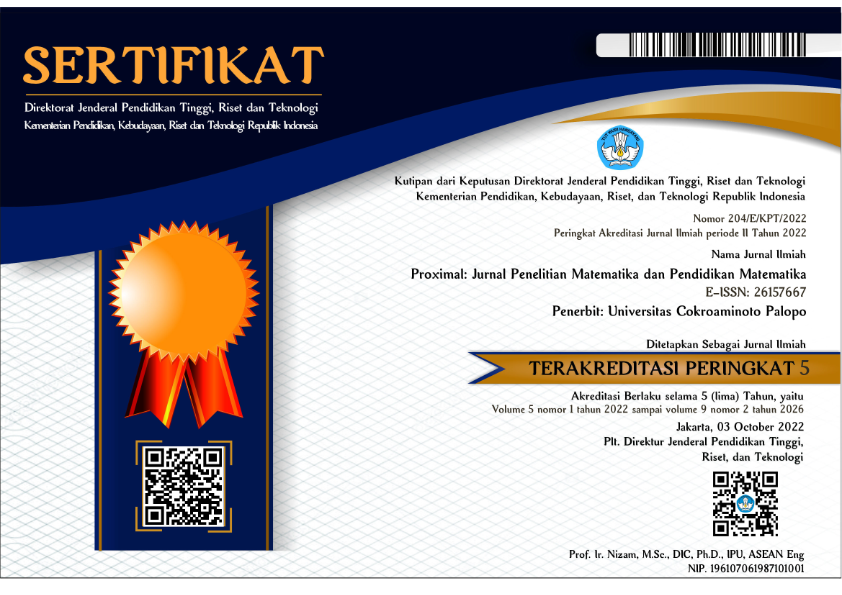Kemampuan Berpikir Kritis Siswa Kelas VIII Ditinjau Dari Adversity Quotient (AQ)
DOI:
https://doi.org/10.30605/proximal.v8i3.6668Keywords:
Kemampuan, Berpikir Kritis, Adversity Quotient, Quitter, Camper, ClimberAbstract
Rendahnya kemampuan berpikir kritis pada siswa kelas delapan SMPN 3 Pariaman menjadi pendorong peneliti dalam melakukan penelitian ini. Masalah lainnya yaitu terdapat perbedaan dalam cara siswa menyikapi tantangan berpikir kritis. Tujuan penelitian ini yaitu untuk mengetahui kemampuan berpikir kritis siswa kelas delapan SMPN 3 Pariaman ditinjau dari adversity quotient (AQ). Penelitian ini menggunakan jenis penelitian dengan pendekatan kualitatif. subjek penelitian ini yaitu 3 orang siswa yang dipilih dengan cara purposive sampling yang memiliki AQ yang berbeda-beda, yaitu 1 subjek dengan AQ tipe quitter, 1 subjek dengan AQ tipe camper dan 1 subjek dengan AQ tipe climber. Instrumen yang digunakan adalah instrumen utama yaitu peneliti dan instrument pendukung yaitu soal tes kemampuan berpikir kritis dan pendoman wawancara. Teknik analisis data yang digunakan yaitu reduksi data, penyajian data serta penarikan kesimpulan. Hasil penelitian yaitu kemampuan berpikir kritis siswa ditinjau dari adversity quotient, subjek dengan AQ tipe quitter mampu memenuhi 1 indikator kemampuan berpikir kritis yaitu interpretasi. Subjek dengan AQ tipe camper mampu memenuhi 3 indikator kemampuan berpikir kritis yaitu interpretasi, evaluasi dan inferensi. Subjek dengan AQ tipe climber mampu memenuhi semua indikator kemampuan berpikir kritis yaitu interpretasi, analisis, evaluasi dan inferensi.
Downloads
References
Fahrum. (2021). Kemampuan Berpikir Kritis Matematis Siswa Smp Melalui Pendekatan Realistic Mathematic Education. Educatif Journal of Education Research, 2(3), 47–52. https://doi.org/10.36654/educatif.v2i3.178 DOI: https://doi.org/10.36654/educatif.v2i3.178
Irfiani, V., Junaedi, I., & Waluya, S. B. (2023). Systematic Literature Review: Kemampuan Berpikir Kritis Matematis Siswa Ditinjau dari Adversity Quotient. Jurnal Pendidikan Matematika, 1(2), 11. https://doi.org/10.47134/ppm.v1i2.157 DOI: https://doi.org/10.47134/ppm.v1i2.157
Putri, N. M., Sumaji, S., & Purwaningrum, J. P. (2023). Profil Kemampuan Berpikir Kritis Matematis Siswa Ditinjau Dari Adversity Quotient (Aq). … Pendidikan Matematika, 8, 407–421.
Rahma, N. N., & Rahaju, E. B. (2020). Proses Berpikir Reflektif Siswa Sma Dalam Menyelesaikan Soal Cerita Matematika Ditinjau Dari Kemampuan Matematika. MATHEdunesa, 9(2), 329–338. https://doi.org/10.26740/mathedunesa.v9n2.p329-338 DOI: https://doi.org/10.26740/mathedunesa.v9n2.p329-338
Rahmaniah, N., Oktaviani, A. M., Arifin, F., Maulana, G., Triana, H., Serepinah, M., & Abustang, P. B. (n.d.). Berpikir Kritis dan Kreatif: Teori dan Implementasi Praktis dalam Pembelajaran. Publica Indonesia Utama.
Selan, R., Mamoh, O., & Wua, Y. P. (2023). Analisis Kemampuan Berpikir Kritis Siswa SMP Ditinjau Dari Adversity Quotient. Mandalika Mathematics and Education Journal, 5, 28–40. https://doi.org/http://dx.doi.org/10.29303/jm.v5i1.4839 DOI: https://doi.org/10.29303/jm.v5i2.6341
Stoltz, P. G. (2020). Adversity quotient: Mengubah Hambatan Menjadi Peluang. Grasindo.
Wulandari, R. D., Pambudi, D. S., Putri, I. W. S., Kurniati, D., & Ambarwati, R. (2022). Analisis Kemampuan Berpikir Kritis Siswa SMA Berdasarkan Adversity Quotient (AQ) pada Materi Sistem Persamaan Linear Tiga Variabel. JNPM (Jurnal Nasional Pendidikan Matematika), 6(4), 624. https://doi.org/10.33603/jnpm.v6i4.6921 DOI: https://doi.org/10.33603/jnpm.v6i4.6921
Downloads
Published
How to Cite
Issue
Section
License
Copyright (c) 2025 latifa asnul fauzi, Haida Fitri, Aniswita Aniswita, Gema Hista Medika

This work is licensed under a Creative Commons Attribution 4.0 International License.
In submitting the manuscript to the journal, the authors certify that:
- They are authorized by their co-authors to enter into these arrangements.
- The work described has not been formally published before, except in the form of an abstract or as part of a published lecture, review, thesis, or overlay journal.
- That it is not under consideration for publication elsewhere,
- That its publication has been approved by all the author(s) and by the responsible authorities – tacitly or explicitly – of the institutes where the work has been carried out.
- They secure the right to reproduce any material that has already been published or copyrighted elsewhere.
- They agree to the following license and copyright agreement.
License and Copyright Agreement
Authors who publish with this journal agree to the following terms:
- Authors retain copyright and grant the journal right of first publication with the work simultaneously licensed under Creative Commons Attribution License (CC BY 4.0) that allows others to share the work with an acknowledgment of the work's authorship and initial publication in this journal.
- Authors are able to enter into separate, additional contractual arrangements for the non-exclusive distribution of the journal's published version of the work (e.g., post it to an institutional repository or publish it in a book), with an acknowledgment of its initial publication in this journal.
- Authors are permitted and encouraged to post their work online (e.g., in institutional repositories or on their website) prior to and during the submission process, as it can lead to productive exchanges, as well as earlier and greater citation of published work.















